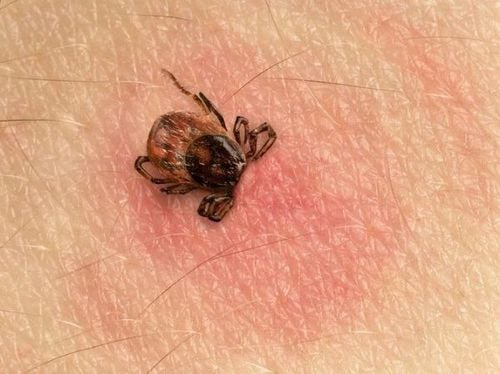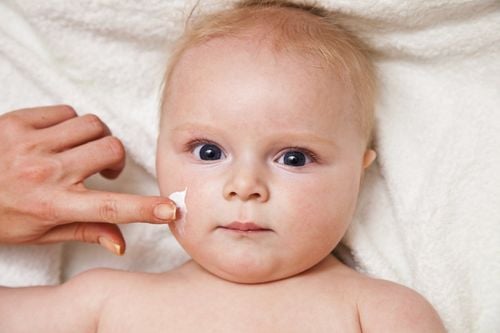This is an automatically translated article.
The article was professionally consulted by Specialist Doctor II Cao Thi Thanh - Department of Pediatrics - Neonatology, Vinmec Hai Phong International General Hospital.Scarlet fever in children is an acute infectious disease that is transmitted to humans through tick larvae. Symptoms of the disease are easily confused, causing misdiagnosis. If not treated properly early, the mortality rate of the disease can be up to 30%.
1. What is fever?
Scarlet fever is an acute infection caused by Orientia tsutsugamushi - obligate intracellular parasitic bacteria. The main reservoir of pathogens is mites infected with Orientia tsutsugamushi. Mosquitoes can transmit pathogens to rodents and small mammals, either vertically through eggs to the next generation, or incidentally to humans. Secondary pathogens are rodents and small mammals such as mice, squirrels, ferrets, rabbits, birds, cattle, poultry,...
The disease is transmitted to humans through mite larvae. When attached to a person, the mite larvae usually sting for 2-3 days, then return to the ground, mature and reproduce the next generation. An infected person is not capable of transmitting the disease to others. Red Mosquitoes usually live in bushes, damp grass, shaded places or in caves. Humans can be infected with stings when living or working in outbreak areas, passing through riverside areas, along streams, entering rock caves, resting on the grass,...
Vietnam is located in endemic areas of typhus. Rats and small mammals - parasitic hosts of red mite larvae - are widely distributed in our country. The disease occurs all year round but mainly occurs in the rainy season, from May to October every year, the peak is in the months of June to July. All ages can be infected. In particular, typhus in children has a high risk.

2. Symptoms of typhus in children
Typical clinical manifestations of typhus in children :
The incubation period lasts 6 - 21 days, the average is 10 - 12 days; The disease usually has a sudden onset with a persistent high fever ≥ 38 - 40 degrees Celsius, lasts 2-3 weeks or more if not treated. There are cases of chills in the first 1-2 days, accompanied by fever, symptoms of severe headache, muscle aches; Appears typical characteristic sores of typhus, usually found on soft, moist skin such as genitals, groin, armpits, neck, ... or in unexpected locations such as navel, ear lobes, eyelids ,... Ulcers are usually painless, can sometimes be itchy, and are usually only a single nodule. The initial burn will gradually develop into a cloudy fluid on a red papule background, after 4-5 days, it will break into a light brown or dark brown scaly nodule. The scab then peels off to reveal the ulcer with a shallow bottom. When the patient's fever is gone, the sores will heal gradually. There are also some cases of children without characteristic ulcers; Swollen lymph nodes at the ulcer site when the patient begins to have a fever or 2-3 days later. Swollen, painful lymph nodes are a sign to detect ulcers. Pediatric patients may also have generalized lymphadenopathy, but the swelling and pain are milder; After 5 - 8 days of fever, a maculopapular rash usually appears all over the body, except for the palms and soles of the feet, the rash may persist for a few hours to 1 week, sometimes with petechiae; During the first week of fever, children often have a lot of cough; At the end of the 2nd week of fever, the child may have pneumonia; If left untreated, fever can persist for 2 weeks or more, then gradually subside within a few days. With treatment, the patient is usually fever-free after 36 hours and can recover quickly.
3. Is typhus in children dangerous?
After passing through the skin, Orientia tsutsugamushi bacteria multiply locally, forming nodules, progressing to pea-sized blisters and scaly necrotic ulcers. From the sores, this bacteria will attack the lymphatic system, causing local lymphadenitis and then systemic lymphadenitis, causing swelling and pain in the lymph nodes. When Orientia tsutsugamushi bacteria grow in the human body, it will cause inflammation of the blood vessels. At this time, the osmotic pressure of the vessel wall increases, leading to plasma leakage, tissue edema, effusion and a number of other complications. At the same time, Orientia tsutsugamushi also enters the bloodstream, resides and develops in the endothelial cells of small blood vessels in all organs such as liver, lung, spleen, kidney, brain, heart,... and causes damage to these organs.
Severe cases, if not detected early and treated actively, typhus in children will become more and more serious and cause dangerous complications such as multi-organ damage, including:
Myocarditis , cardiovascular collapse; Disseminated intravascular coagulation; Severe pneumonia, respiratory failure; Inflammation of the brain and meninges; Hepatotoxicity, hepatosplenomegaly, elevated liver enzymes; Kidney disease; Septic shock; Hemorrhage in stool, vomiting and hemoptysis. The course of the disease will vary from mild to complicated due to multiple organ damage. There are quite a lot of children with fever who died because they were not detected and treated in time.
Besides dangerous complications, typhus in children also has a slow recovery time and the recovery time lasts 1-2 weeks. In addition, the disease also has a high recurrence rate despite treatment. Recurrence usually occurs 5-14 days after the fever has stopped. The cause of recurrence is that the drug used only inhibits the growth of bacteria, not killing Orientia tsutsugamushi.

4. Why is typhus in children dangerous?
Scarlet fever in children is considered dangerous because the diagnosis is difficult. Specifically, for patients with fever and sores, because there are no signs of pain, itching, and sores in difficult-to-detect locations, little attention is paid to them. With 30% of patients with red molluscum contagiosum do not appear sores, the diagnosis of the disease is even more difficult, requiring doctors with experience, expertise and support from modern medical technology. .
Besides, the initial sign of tick fever is high fever and some atypical symptoms. Therefore, the initial diagnosis at the grassroots level is difficult, making it easy to misdiagnose other diseases such as dengue fever, malaria, typhus, typhoid fever, acute viral infection, spirochete infection. jaundice, sepsis, meningococcal infection,... The definitive diagnosis of the disease must be based on the tick bite and specific antibodies in the blood.
5. Treatment of typhus in children
Treatment of adult typhus is mainly using specific antibiotics such as chloramphenicol, tetracycline or doxycycline. For children and pregnant women will be indicated to use azithromycin or chloramphenicol.
Antibiotics often work very quickly, helping patients quickly get rid of fever and improve their overall condition. However, note that the drug only has a bacteriostatic effect, reducing the growth rate of bacteria while waiting for the body to create immunity. Therefore, patients should not stop antibiotics too soon, especially in the early days of fever to avoid the risk of disease recurrence.

6. Measures to prevent typhus in children
Mosquitoes and larvae prefer to live in porous, cool, moist soils and in caves, along rivers and streams, where there are bushes, low trees, etc. To prevent tick fever in children, the Parents should follow these guidelines:
Clear bushes around the house; Spray insecticides: Should be sprayed on damp soil and under 20cm tall bushes around the house, in a shady place; Seasonal rat extermination, should be sprayed with insecticide before killing rats; When going on a picnic, children should wear long-sleeved clothes, avoid sitting, lying down, putting backpacks, drying clothes on the lawn or near the edge of bushes or trees; Moisten clothes with mite repellent or use anti-mite creams when letting children play in dusty, humid areas. Scarlet fever in children is very dangerous and has a high risk of death. Therefore, when children have symptoms of suspected illness such as persistent high fever, rash, swollen lymph nodes, sores, etc., parents should quickly bring their children to the nearest medical center for examination and treatment. Do tests, avoid self-administered long-term antipyretic drugs because they can make the disease worse.
As a key area of Vinmec Health system, Pediatrics Department always brings satisfaction to customers and is highly appreciated by industry experts with:
Gathering a team of top doctors and nurses in Pediatrics : consists of leading experts with high professional qualifications (professors, associate professors, doctorates, masters), experienced, worked at major hospitals such as Bach Mai, 108.. Doctors All doctors are well-trained, professional, conscientious and knowledgeable about young psychology. In addition to domestic pediatric specialists, the Department of Pediatrics also has the participation of foreign experts (Japan, Singapore, Australia, USA) who are always pioneers in applying the latest and most effective treatment regimens. . Comprehensive services: In the field of Pediatrics, Vinmec provides a series of continuous medical examination and treatment services from Newborn to Pediatric and Vaccine,... according to international standards to help parents take care of their baby's health from birth to childhood. from birth to adulthood Specialized techniques: Vinmec has successfully deployed many specialized techniques to make the treatment of difficult diseases in Pediatrics more effective: neurosurgery - skull surgery, stem cell transplantation. blood in cancer treatment. Professional care: In addition to understanding children's psychology, Vinmec also pays special attention to the children's play space, helping them to have fun and get used to the hospital's environment, cooperate in treatment, improve the efficiency of medical treatment. Dr. Thanh has worked for 25 years in the treatment of neonatal diseases, of which 23 years worked at the neonatal department of Hai Phong Obstetrics and Gynecology Hospital (with experience in neonatal resuscitation in the operating room/delivery room). + late-term care of premature babies (34 weeks - 37 weeks), 02 years working at Hai Phong Children's Hospital Requesting Clinic.Dr. Thanh is currently working in Pediatrics - Neonatology Department of Vinmec International General Hospital Hai Phong
Please dial HOTLINE for more information or register for an appointment HERE. Download MyVinmec app to make appointments faster and to manage your bookings easily.














